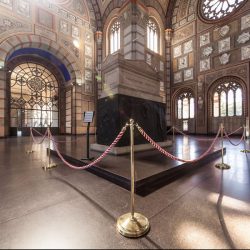
Milan Monumental Cemetery
It might be the last place where people would look, but the monumental cemetery, or Cimitero Monumentale, is truly an artistic sight to behold. Filled with unique Italian sculptures, obelisk, shrines and tombs where the dead are honored with elaborate displays of heavenly themed grief and hope symbolism. A lot of famous Milanese sculptors have worked on projects that can be seen here, which shows in the sheer craftsmanship and diversity in the works that can be found here. A lot of famous people from Milan lay here, like the father of Einstein and Salvatore Quasimodo. The Milanese tradition to honor their people with monumental art pieces have turned this cemetery into a public museum that can be appreciated by everyone.
Some of the most famous people are honored in the marble building called the Famedio, which is also one of the biggest highlights as you will find the tomb of Alessandro Manzoni here. Other highlights are for example the Tomb of Antonio Bernocchi and the Campari family tomb, where the famous Jesus’s last supper is recreated with sculptures.
Location: Piazzale Cimitero Monumentale, 20154 Milan, Italy
Category: The best places for sightseeing in Milan
Leave a review or reply